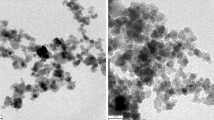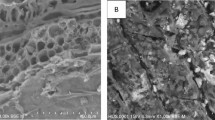Abstract
Phthalate esters (PAEs) can interfere with the endocrine systems of humans and wildlife. The main objective of this study was to evaluate the suitability of a composite for remediating marine sediments contaminated with PAEs. The composite was synthesized with magnetite nanoparticles (Fe3O4) and rice husk biochar (RHB) by using chemical co-precipitation. Fe3O4, RHB, and Fe3O4–RHB substantially activated sodium persulfate (Na2S2O8, PS) oxidation to form SO4−• and thus degrade PAEs in marine sediments in a slurry system. The morphology and structural composition of the magnetic composites were examined using XRD, FTIR, environmental scanning electron microscopy–energy-dispersive X-ray spectrometry, and superconducting quantum interference device. The Fe3O4–RHB composites were confirmed to be prepared successfully. The influences of various parameters, including the PS concentration, composite loading, and initial pH, were investigated. The concentration of high-molecular-weight PAEs (HPAEs) in sediment was much higher than that of low-molecular-weight PAEs (LPAEs); di-(2-ethylhexyl) phthalate (DEHP) was an especially salient marker of PAE contamination in sediments. Furthermore, increasing the PS and Fe3O4–RHB doses accelerated PAE oxidation at pH 3.0; 83% degradation of PAEs was achieved when the PS and Fe3O4–RHB concentrations were increased to 2.3 × 10−2 mM and 1.67 g/L, respectively. LPAEs such as dibutyl phthalate (DnBP) are easier to degrade than HPAEs such as DEHP, diisononyl phthalate (DINP), and diisodecyl phthalate (DIDP). In addition, possible activation mechanisms of the interactions between S2O82− and Fe2+/Fe3+ on the Fe3O4 surface, which involve an efficient electron transfer mediator of the RHB oxygen functional groups promoting the generation of SO4−• in the Fe3O4–RHB/PS system, were clarified. Thus, the Fe3O4–RHB/PS oxidation process is expected to be a viable method for remediating PAE-contaminated marine sediment.












Similar content being viewed by others
References
Abdul G, Zhu X, Chen B (2017) Structural characteristics of biochar-graphene nanosheet composites and their adsorption performance for phthalic acid esters. Chem Eng J 319:9–20
Chen CF, Binh NT, Chen CW, Dong CD (2015) Removal of polycyclic aromatic hydrocarbons from sediments using sodium persulfate activated by temperature and nanoscale zero-valent iron. J Air Waste Manage Assoc 65:375–383
Cheng M, Zeng G, Huang D, Yang C, Lai C, Zhang C, Liu Y (2017) Advantages and challenges of Tween 80 surfactant-enhanced technologies for the remediation of soils contaminated with hydrophobic organic compounds. Chem Eng J 314:98–113
Darroudi M, Hakimi M, Goodarzi E, Oskuee RK (2014) Superparamagnetic iron oxide nanoparticles (SPIONs): green preparation, characterization and their cytotoxicity effects. Ceram Int 40:14641–14645
Dong CD, Tsai ML, Chen CW, Hung CM (2017a) Heterogeneous persulfate oxidation of BTEX and MTBE using Fe3O4–CB magnetite composites and the cytotoxicity of degradation products. Int Biodeter Biodegr 24:109–118
Dong CD, Chen CW, Hung CM (2017b) Synthesis of magnetic biochar from bamboo biomass to activate persulfate for the removal of polycyclic aromatic hydrocarbons in marine sediments. Bioresour Technol 245:188–195
Dong CD, Tsai ML, Chen CW, Hung CM (2018a) Remediation and cytotoxicity study of polycyclic aromatic hydrocarbon-contaminated marine sediments using synthesized iron oxide–carbon composite. Environ Sci Pollut Res 25:5243–5253
Dong CD, Chen CW, Kao CM, Chien CC, Hung CM (2018b) Wood-biochar-supported magnetite nanoparticles for remediation of PAH-contaminated estuary sediment. Catalysts 8:73–86
Fang G, Gao J, Liu C, Dionysiou DD, Wang Y, Zhou D (2014) Key role of persistent free radicals in hydrogen peroxide activation by biochar: implications to organic contaminant degradation. Environ Sci Technol. 48:1902–1910
Fang G, Liu C, Gao J, Dionysiou DD, Zhou D (2015) Manipulation of persistent free radicals in biochar to activate persulfate for contaminant degradation. Environ Sci Technol. 49:5645–5653
Ferrarese E, Andreottola G, Oprea IA (2008) Remediation of PAH-contaminated sediments by chemical oxidation. J Hazard Mater 152:128–139
Gao DW, Wen ZD (2016) Phthalate esters in the environment: a critical review of their occurrence, biodegradation, and removal during wastewater treatment processes. Sci Total Environ 541:986–1001
Herath I, Kumarathilaka P, Al-Wabel MI, Abduljabbar A, Ahmad M, Usman ARA, Vithanage M (2016) Mechanistic modeling of glyphosate interaction with rice husk derived engineered biochar. Microporous Mesoporous Mater 225:280–288
Hu X, Gu Y, Huang W, Yin D (2016) Phthalate monoesters as markers of phthalate contamination in wild marine organisms. Environ Pollut 218:410–418
Huang J, Li X, Ma M, Li D (2017) Removal of di-(2-ethylhexyl) phthalate from aqueous solution by UV/peroxymonosulfate: influencing factors and reaction pathways. Chem Eng J 314:182–191
Hung CM, Chen CW, Liu YY, Dong CD (2016a) Decolorization of methylene blue by persulfate activated with FeO magnetic particles. Water Environ Res 88:675–686
Hung CM, Chen CW, Jhuang YJ, Dong CD (2016b) Fe3O4 magnetic nanoparticles: characterization and performance exemplified by the degradation of methylene blue in the presence of persulfate. J Adv Oxid Technol 19:43–51
Ismail L, Ferronato C, Fine L, Jaber F, Chovelon JM (2017) Elimination of sulfaclozine from water with SO4 –• radicals: evaluation of different persulfate activation methods. Appl Catal B Environ 201:573–581
Jung KW, Choi BH, Jeong TU, Ahn KH (2016) Facile synthesis of magnetic biochar/Fe3O4 nanocomposites using electro-magnetization technique and its application on the removal of acid orange 7 from aqueous media. Bioresour Technol 220:672–676
Kataki S, Hazarika S, Baruah DC (2017) Investigation on by-products of bioenergy systems (anaerobic digestion and gasification) as potential crop nutrient using FTIR, XRD, SEM analysis and phyto-toxicity test. J Environ Manag 196:201–216
Kong L, Lu X, Bian X, Zhang W, Wang C (2011) Constructing carbon-coated Fe3O4 microspheres as antiacid and magnetic support for palladium nanoparticles for catalytic applications. ACS Appl Mater Interfaces 3:35–42
Laurent S, Forge D, Port M, Roch A, Robic C, Elst LV, Muller RN (2008) Magnetic iron oxide nanoparticles: synthesis, stabilization, vectorization, physicochemical characterizations, and biological applications. Chem Rev 32:2064–2110
Leng L, Yuan X, Zeng G, Shao J, Chen X, Wu Z, Wang H, Peng X (2015) Surface characterization of rice husk bio-char produced by liquefaction and application for cationic dye (Malachite green) adsorption. Fuel 155:77–85
Li H, Wan J, Ma Y, Wang Y (2016a) Synthesis of novel core–shell Fe0@Fe3O4 as heterogeneous activator of persulfate for oxidation of dibutyl phthalate under neutral conditions. Chem Eng J 301:315–324
Li H, Wan J, Ma Y, Wang Y (2016b) Reaction pathway and oxidation mechanisms of dibutyl phthalate by persulfate activated with zero-valent iron. Sci Total Environ 562:889–897
Li R, Liang J, Gong Z, Zhang N, Duan H (2017) Occurrence, spatial distribution, historical trend and ecological risk of phthalate esters in the Jiulong River, Southeast China. Sci Total Environ 580:388–397
Li P, Liu Z, Wang X, Guo Y, Wang L (2017) Enhanced decolorization of methyl orange in aqueous solution using iron-carbon micro-electrolysis activation of sodium persulfate. Chemosphere 180:100–107
Li Y, Wang X, Zhu Y, Wang L, Wang L (2012) In situ preparation of biochar coated silica material from rice husk. Colloid Surf A: Physicochem Eng Asp 395:157–160
Lu T, Xue C, Shao J, Gu JD, Zeng Q, Luo S (2016) Adsorption of dibutyl phthalate on Burkholderia cepacia, minerals, and their mixtures: behaviors and mechanisms. Int Biodeter Biodegr. 114:1–7
Net S, Sempéré R, Delmont A, Paluselli A, Ouddane B (2015) Occurrence, fate, behavior and ecotoxicological state of phthalates in different environmental matrices. Environ Sci Technol 49:4019–4035
Ni SQ, Ni J, Yang N, Wang J (2013) Effect of magnetic nanoparticles on the performance of activated sludge treatment system. Bioresour Technol 143:555–561
Ren W, Tang D, Lu X, Sun J, Li M, Qiu S, Fan D (2016) Novel multilayer ACF@rGO@OMC cathode composite with enhanced activity for electro-Fenton degradation of phthalic acid esters. Ind Eng Chem Res 55:11085–11096
Wang C, Hua Y, Li G, Tong Y, Li Y (2008) Indirect cathodic electrocatalytic degradation of dimethylphthalate with PW11O39Fe(III)(H2O)4− and H2O2 in neutral aqueous medium. Electrochim Acta 53:5100–5105
Wu Y, Zhang P, Zhang H, Zeng G, Liu J, Ye J, Fang W, Gou X (2016) Possibility of sludge conditioning and dewatering with rice husk biochar modified by ferric chloride. Bioresour Technol 205:258–263
Xuan S, Wang F, Lai JMY, Sham KWY, Wang YXJ, Lee SF, Yu JC, Cheng CHK, Leung KCF (2011) Synthesis of biocompatible, mesoporous Fe3O4 nano/microspheres with large surface area for magnetic resonance imaging and therapeutic applications. ACS Appl Mater Interfaces 3:237–244
Yang E, Jun M, Haijun H, Wenfu C (2015) Chemical composition and potential bioactivity of volatile from fast pyrolysis of rice husk. J Anal Appl Pyrolysis 112:394–400
Yang GCC, Huang SC, Wang CL, Jen YS (2016) Degradation of phthalate esters and acetaminophen in river sediments using the electrokinetic process integrated with a novel Fenton-like process catalyzed by nanoscale schwertmannite. Chemosphere 159:282–292
Ye T, Kang M, Huang Q, Fang C, Chen Y, Liu L, Dong S (2016) Accumulation of di(2-ethylhexyl) phthalate causes endocrine-disruptive effects in marine medaka (Oryzias melastigma) embryos. Environ Toxicol 31:116–127
Yi S, Gao B, Sun Y, Wu J, Shi X, Wu B (2016) Removal of levofloxacin from aqueous solution using rice-husk and wood-chip biochars. Chemosphere 150:694–701
Zhang X, Feng M, Qu Q, Liu H, Wang L, Wang Z (2016) Catalytic degradation of diethyl phthalate in aqueous solution by persulfate activated with nano-scaled magnetic CuFe2O4/MWCNTs. Chem Eng J 301:1–11
Zhao D, Liao X, Yan X, Huling SG, Chai T, Tao H (2013) Effect and mechanism of persulfate activated by different methods for PAHs removal in soil. J Hazard Mater 254-255:228–235
Zhao SY, Lee DK, Kim CW, Cha HG, Kim YH, Kang YS (2006) Synthesis of magnetic nanoparticles of Fe3O4 and CoFe2O4 and their surface modification by surfactant adsorption. Bull Kor Chem Soc 27:237–242
Zhao M, Cheng M, Zeng G, Zhang C (2018) Degradation of di (2-ethylhexyl) phthalate in sediment by a surfactant-enhanced Fenton-like process. Chemosphere 198:327–333
Funding
This work was granted financial support from the Ministry of Science and Technology of Taiwan to perform this study under Contract Nos. MOST 106-2221-E-022-002-MY3 and 106-2221-E-022-003-MY3.
Author information
Authors and Affiliations
Corresponding author
Additional information
Responsible editor: Philippe Garrigues
Rights and permissions
About this article
Cite this article
Dong, CD., Chen, CW. & Hung, CM. Persulfate activation with rice husk-based magnetic biochar for degrading PAEs in marine sediments. Environ Sci Pollut Res 26, 33781–33790 (2019). https://doi.org/10.1007/s11356-018-2423-2
Received:
Accepted:
Published:
Issue Date:
DOI: https://doi.org/10.1007/s11356-018-2423-2




